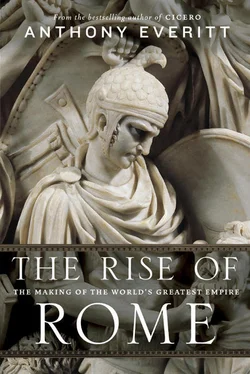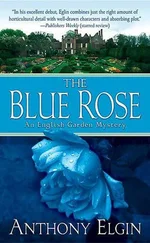Roman historians in the last days of the Republic did not necessarily imagine things, but they tended to see remote and legendary events through the eyes of their own time. The fact that Romulus developed despotic tendencies and was assassinated in the Senate House may very well reflect a response to the traumas of their own day. Hence the uncanny pre-echoes in Livy of Caesar’s death.
There was much discussion about the date of Rome’s foundation. Most commentators favored a year sometime in the eighth century. As we have seen, 753 was the choice of Varro. It became the generally accepted date. This led to a second chronological conundrum. Only seven kings reigned between Romulus and the expulsion of the Tarquins. This meant an implausibly long average reign of thirty-five years apiece.
The Romans accepted this, but modern scholars have been more skeptical. Perhaps there were additional kings, of whom no record survives. Archaeologists seem to have settled the question: slight traces of primitive settlements have been found that go back many hundreds of years, but solid evidence of city as distinct from village life begins only in the middle of the seventh century. So the real foundation date was about one hundred years later than originally believed. This has helped, for although some monarchs may have slipped from view, the canonical number now fits comfortably into the time available. Also, bits of dug-up evidence begin to fall into place alongside the literary tradition. Thus, the Regia, or palace, in the Forum was constructed in the late seventh century, just where the new chronology places the reign of Numa Pompilius, who is credited with having commissioned it. Rome’s first Senate House was attributed to Tullus Hostilius (hence its name, the Curia Hostilia): its remains have been identified, dating to the early sixth century, when we now suppose that Tullus ruled Rome.
It is a long time before we meet personalities who are (more or less) certain to have lived in history as distinct from myth. The first four kings seem to be largely if not entirely fictional, even if events in their reigns did actually take place. They were each given specialist tasks, which were in truth accomplished during the monarchy, but not necessarily by one particular king.
Romulus established an orderly social and political system with tribes and curiae; the un-warlike Numa was allocated everything concerning religion and (in Cicero’s phrase) “the spirit of tranquillity”—cults, priestly colleges and a public calendar of sacred and secular days; the untranquil Tullius Hostilius and Ancus Marcius fought expansionist wars with an effective conscript army. Whether or not Ancus himself had anything to do with it, Ostia and the Pons Sublicius were certainly built. However, we can say with confidence that the two Tarquins and Servius Tullius lived real lives (although, because their recorded achievements are very similar, the Tarquins may have been only one person). The best estimate proposes that Priscus came to power between 570 and 550 B.C.
As we approach the end of the monarchy, the picture comes more and more sharply into focus. Although the story of Lucretia was “written up,” its melodramatic trappings may conceal a true-life scandal. Even if we are suspicious of his antic disposition, Brutus is a major historical figure who helped establish the republican institutions that lasted for more than five hundred years.
Once we lift the mists of myth, we can make out a landscape of fact. Having comprehensively rubbished the traditional narratives, we have to concede that they do, after all, contain important ingredients of historical reality. During the monarchy, Rome did grow from being a small town beside a ford into a power in central Italy, extending its territory by countless miniature wars with local tribes in Latium. Political institutions such as the Senate and the People’s Assembly were developed, and it is almost certainly the case that some method of linking wealth to political influence and military obligation was invented by the kings, and very probably by a ruler named Servius Tullius. (However, the details of the complicated centuriate system refer to a later period, for Romans tended toward a modernizing fallacy; namely, they supposed that the early Republic was identical to, if smaller than, its more elaborate incarnation in subsequent centuries.)
So a recognizable constitution evolved, as did an unresolved conflict between ordinary citizens and the lordly patricians. The later kings were indeed very like turannoi , who claimed a popular mandate, carried out aggressive foreign policies, and invested in the arts and architecture.
The grand public edifices that a thriving and ambitious city-state demanded were indeed built; the Forum was transformed from a muddy bog into a great public square. Some have argued that, for a time, Rome was forcibly enlisted as an Etruscan city, but recent scholars have demurred for lack of evidence. It seems that, although deeply influenced by the imperial Etruscan civilization to the north, where it obtained two of its kings, Rome retained a fierce independence.
It developed its own culture as a diverse community, welcoming to outsiders but proud of its own, traditional way of doing things. These two character traits were as old as the earliest stories about Rome. After all, it was Romulus who made a point of inviting foreigners to become citizens, and his successor Numa Pompilius, who, so Cicero claimed, introduced “religious ceremonial [and] laws which still remain on our records.” Indeed, a cosmopolitan openness to the world and fidelity to the mos maiorum , the Latin term for “ancestral custom,” may have been interrelated: if social cohesion was to be maintained, the one needed to be corrected by, or balanced with, the other. In any event, this was a tension that would mark Rome’s subsequent history.
AS ROMANS OF the first century—Cicero and his friends, for instance—looked at themselves in the mirror of a distant, royal past, what did they see? First and foremost, they were a chosen people. It was their destiny to found the world’s greatest empire. By their feats of arms, they would outdo the Mediterranean’s dominant power, the Greeks, whose arts and culture and military successes were unparalleled. As Trojans, they were not barbarians beyond the pale of civilization but guest Hellenes. And, as Trojans, they would at last make good the fall of Troy.
Rome was not built in a day. In many foundation myths, cities suddenly appear from nowhere, fully grown and ready to go. Not so with Rome: Romulus, the official founder, was merely a milestone in an immensely long process that began in the embers of Troy and ended in Lucretia’s bedroom. The story really gets going properly only with the expulsion of the Tarquins and the arrival of the Republic.
The Romans were deeply religious, but their religion, much influenced by the Etruscans, was little more than a complex web of superstitions. The gods were incalculable powers who had to be placated at every turn. Every aspect of life was governed by ritual procedures, whether it be the repair and maintenance of a bridge or the business of making a treaty.
This was a highly aggressive society, but one that understood a vital political truth: military victory can be secured only by reconciliation with the defeated. Although most empire-builders in the ancient world were cruel and unforgiving, this was not altogether an original insight. Thus, after his conquest of the Persian Empire in the fourth century, and much to the fury of his trusty Macedonians, Alexander the Great promoted leading Orientals to positions of power in his new administration and insisted on harmony between victor and vanquished. In a move that recalls the rape of the Sabine women, he even forced his soldiers to marry local women. What was remarkable about the Romans was the consistency, over many centuries, with which they pursued their policy. They could see that it enabled them not only to foster consent to their rule among their former enemies but also to constantly enlarge their population and, by the same token, the manpower available to their armies.
Читать дальше








